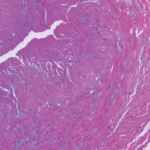Kenneth J. Warrington, MD, professor of medicine at the Mayo Clinic in Rochester, Minn, says the researchers’ decision to consider healed arteritis as positive for GCA is a problem. “That is a very controversial topic,” he says. “The definition of what is called healed arteritis is not clear, and there is debate among pathologists as to what that represents. It may be a very nonspecific finding that can even be seen in a normal elderly patient. It is a nonspecific pathologic description.
“If I were designing the study, I would not consider healed arteritis as positive for GCA,” Dr. Warrington says.
Invalid Comparisons
The retrospective research for the prediction model used logistic regression to compare the model with the 1990 American College of Rheumatology criteria for disease classification.4 Dr. Ing and colleagues reported that the prediction model outperformed the ACR criteria.
Dr. Grayson says the comparison isn’t valid. The criteria were not intended for diagnosis, but instead were intended to help classify the disease relative to other forms of vasculitis. In addition, the reported model only predicts temporal artery biopsy results rather than diagnoses GCA, another reason a comparison is invalid, he says.
Further, according to Leonard Calabrese, DO, professor of medicine at the Cleveland Clinic Lerner College of Medicine of Case Western Reserve University in Cleveland, Ohio, the ACR criteria are now considered “out of date and out of touch with our current understanding of GCA.” Dr. Calabrese was one of the authors of the 1990 criteria.
There are efforts underway to update the classification criteria, according to Dr. Warrington. Updates are needed because the 1990 criteria do not include CRP, which is now a widely used marker of inflammation, and the criteria don’t incorporate imaging either.
So Is It a Good Tool?
The rheumatologists contacted for this article pondered whether the researchers’ prediction model moves the field forward as a type of diagnostic tool. “The authors are getting at whether you could not pursue a biopsy in a patient where you have low probability. It is a reasonable question, but in the clinical context I would be hesitant to say I am basing a decision on a prediction model and therefore I am not going to send the patient for biopsy,” says Dr. Warrington.
GCA is a disease in which “you don’t have a lot of room for error,” he says, because patients suffer devastating consequences if the diagnosis is missed. “We like to have confirmation of the diagnosis because treatment is not trivial and includes several years of glucocorticoids and perhaps other immunosuppressive agents, which all have side effects. A negative biopsy can help exclude a GCA diagnosis, even if the initial suspicion is low,” he says.

